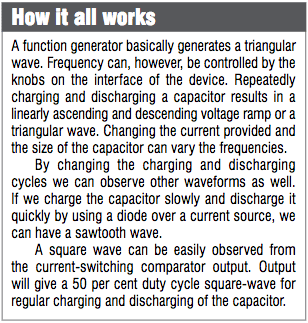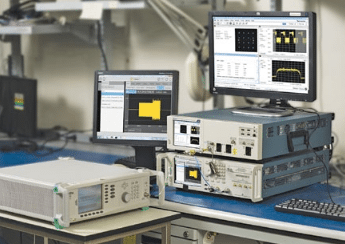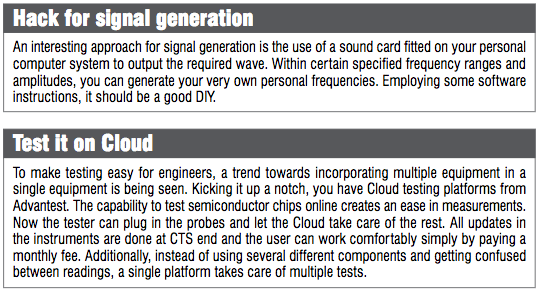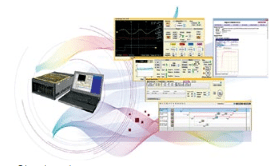Not so long ago, dial based function generators were in high demand. With advancing technologies, these have become outdated and now, with computer control, generating a single frequency can be redefined. Additionally, with multi channel generators and digital signal generation, there is not much that cannot be done via a function generator.
Function generators have many applications, ranging from observation of a simple sinusoidal waveform to being used as a signal source to test amplifiers, or to introduce an error signal into a control loop. We also have equipment generating synchronised signals suitable for television and other broadcasts, including horizontal and vertical sync pulses (in analogue) or sync words (in digital). Let us take a look at some of these advancing test and measurement equipment.

Emerging features in a function generator
Today is an era of computers. If we can control a function generator via a computer, it can become very easy for people to work with it. There are manufacturers developing equipment that can be connected to a computer, and the frequency to be generated can be fine-tuned. Pico Source PG900 series is one such example.

“We see a trend towards multichannel generators, two channels at least, but there is also a need for four channels and more,” says Appalla Srinivasa Rao, manager – product support and application, Rohde & Schwarz India. Such multichannel generators are very fruitful in comparing multiple signals for education purposes, along with testing for optimum performance. “Beside these trends, simple single-channel arbitrary generators are being more and more integrated in other equipment like oscilloscopes, which will significantly reduce the market for this basic type,” explains Rao.
The function genarator acts as a source for a quasi-digital bit-stream that may be modulated by arbitrary analogue waveforms to simulate signal distortion. Bit patterns may have significant length, preventing the use of traditional arbitrary editors, and require modification of the remote command set by adding pattern commands and storing the integrated arbitrary memory.
Testers need precision
Signal generation from a single clock
Newer function generators, known as arbitrary waveform generators (AWGs), employ direct digital synthesisers (DDSes) in signal generation. DDSes can be used for creating arbitrary waveforms from a single, fixed-frequency reference clock.
Use of DDS has been another advantage in coming up with high-frequency devices. A DDS has many advantages over the earlier phase-locked loop (PLL), including much better frequency agility, improved phase noise and precise control of the output phase across frequency-switching transitions.
Trueform technology from Keysight offers standard features along with baseband I-Q player, 80MHz and 120MHz with one and two channels, two-channel coupling and synchronisation, Trueform waveform sequencing and PRBS series patterns. “Trueform technology offers more capability, fidelity and flexibility,” says Kishore S., application engineer, Keysight Technologies India Pvt Ltd. 33600A and 33500B series Trueform waveform generators from Keysight feature this technology.
Flexible equipment design
Rao says, “Our preferred implementation is based on FPGAs containing several DDSes, thus providing maximum flexibility at reasonable prices.It allows us to tailor the instrument to the needs of big-volume customers.”
Today, most function generators adopt a digital approach. Analogue function generators are still used as these can provide levels of performance that are more than satisfactory for exact requirements needed in many development laboratories. Also, analogue function generators tend to be much cheaper.

Oh, the challenges

“Some test challenges are generating a waveform with many points, simulating signals with high integrity, synchronising two signals to generate pseudorandom binary sequence signals, creating differential signals, changing one segment of arb without redesigning the whole signal and needing to sweep arb through a set of different frequencies,” says Kishore
Another matter of concern with function generators is the price. “Price is, as usual, an issue,” adds Rao. However, with the release of multiple test equipment incorporated in a single device, this should not be a major issue now. Bringing the best in technology also has its problems that can correlate to cost. “The time to market causes the product to be designed with the latest processors to be delayed,” says Mahadevan.
Could there be a wave of change
Addition of multiple testers in a single piece of equipment has been the manufacturing strategy for some time now. When you incorporate multiple equipment with a familiar computer interface, working with the equipment will be highly simplified.
Looking forward, we can surely expect some other integration into the function generator. If the cost challenges can be somehow handled, a function generator can be regularly updated. And it would not just lie on the corner table for an entire year to be used only once in a while.






